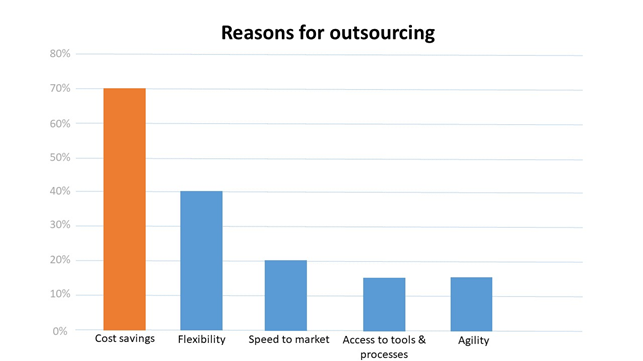Custom software development is the main segment of the IT services market that allows companies to boost digital transformation. Businesses all across the globe, whatever their sphere of activity is, may outsource software development to increase efficiency, focus on the core business activities, and reduce costs. Despite this, nearshore and offshore outsourcing may be perceived as risky activities. That’s why we’re going to dive deeper and find out true pros and cons as well as types of outsourcing, revealing possible reasons why 78% of businesses in different parts of the world feel positive about their outsourcing partners and what can be considered perilous in the delegation of software development to other companies.
For starters, we should explain the types of outsourcing. Offshore outsourcing implies hiring third-party suppliers that perform software development tasks and are located outside of the customer’s home base. In this case, vendor’s operations occur in distant countries, while hiring people in neighboring countries represents the practice of nearshore outsourcing. The last type is onshore outsourcing: a vendor, or provider, sends the team of experts, e. g. software engineers, to the customer’s location. By opting for onshore outsourcing, companies easily monitor working processes, though the possibility of cost savings is doubtful.
Benefits of IT outsourcing
· Flexibility
Companies may need an employee or even a team with particular skills for a short period – outsourcing covers this necessity, thus eliminating the need to hire in-house technical experts in the area of rapidly changing technologies. Businesses become more flexible and avoid additional efforts put into finding a specialist, arranging on boarding activities with role-specific training, providing mentorship, and so on.
Turning to outside providers enables gaining access to the best technologies and talents, yet real outcomes depend on the outsourcing partner. The outsourcing team should adapt to internal processes and be flexible enough to adjust to changing business operations. If any shift to a new direction occurs, the IT provider is required to refine the software development processes in accordance with the emerging needs. Otherwise, the flexibility as an advantage of IT outsourcing will disappear.
· Reduced expenses
According to Deloitte’s 2020 Global Outsourcing Survey, which involved interviewing 40 executives, cost reduction is still the desirable objective of organizations that resort to outsourcing. This was confirmed before COVID-19 and is still actual, although the pandemic is one of the most disruptive events that influenced the global economy and outsourcing relationships.
IT outsourcing reduces a company’s expenses in a few different ways:
- Lower salaries and employee benefits
- No need to expand an office space (even during COVID-19 the in-house team may wish to visit the office at least from time to time, which requires additional workspace)
- Lower costs for equipment and utility (with an outsourcing partner, companies don’t need to invest more funds in IT infrastructure)
- Expansion of the team involved in hiring and operational activities may be avoided
How much do businesses save implementing the IT outsourcing model instead of hiring an internal software development team? The answer to this question depends on the outsourcing destination, maturity of the chosen provider and team, managed IT services pricing, types of services.
Outsourcing software development services may include project management, UI/UX design, quality assurance, technical writing, and so on. Total costs also depend on the type of the project, which may imply the development of new software, app modernization, integration, or custom software development.
· Wide pool of talents
Lack of experts, both tech and non-tech specialists who may be involved in software development, intricate the process of building in-house teams. According to Eurostat, nearly 53% of European companies face difficulties while recruiting IT professionals. An IT outsourcing partner helps these companies to address the challenge: they get access to talents with rare skills who are capable of creating a new digital solution.
Businesses reap outsourcing benefits by establishing partnerships with software development partners from Ukraine, Poland, India, Romania, Brazil, Mexico, Argentina, China, the Philippines, and so on.
· Significant time saving
If companies have any valuable ideas to be implemented, they can augment the team or create a new one from scratch through cooperation with the IT outsourcing partner. Companies grant a competitive advantage by ensuring the functioning of the team that consists of engineers with the right set of skills in the shortest possible time. In contrast, hiring an engineer with a rare set of skills can take 3 or even more months, which causes disruption and financial losses.
· Improved Security & Compliance
Crucial components of any business include the security of the network, backup, data recovery, and compliance. The outsourcing partner can assist in managing security and compliance, implementing measures and compliance that are relevant for the industry. Outsourcing companies are frequently interested in a high level of security and compliance since their work, reputation, and revenue depend on these factors.
Briefly about the risks and risk mitigation
Risks that companies face in everyday activity differ from operational, data security, and compliance, to reputational. Outsourcing is associated with risks related to technical mistakes, software failures, and wrong process management, but, indeed, the type and amount of risks depend on the IT provider and can be fully avoidable. Moreover, in the case of literate planning and solid preparation, companies tend to choose a reliable partner with relevant domain expertise. Such a partner will help to avert risks connected to processes and people and allow customers to focus on core business activity, ensuring the confidentiality of sensitive information and sustainable product development.
Another risk that may be named by businesses interested in software development outsourcing is the time zone difference. If the time difference constitutes 7 hours or more (equivalent to the whole business day), customers have a chance to go Agile, organize the sustainable communication model, and stick to the “follow the sun” model. This model implies that the offshore team works during the client’s night time, and the client receives results of their work in the morning.
However, if you’re still wondering whether it’s a good idea to outsource software development projects, there is no reason to put everything on the line – just start with a pilot project or MVP to evaluate the vendor’s expertise and soft skills, checking whether the contractor is competent. It will be thoughtful spending.
Want to find out how your company can reduce costs for software development? Get in touch with experts to discuss IT outsourcing in more detail.
Website: https://cybercraftinc.com/
Phone: +380 63 991 1633
Email: [email protected]
Original Source of the original story >> Outsourcing Software Development – Benefits and Risks







